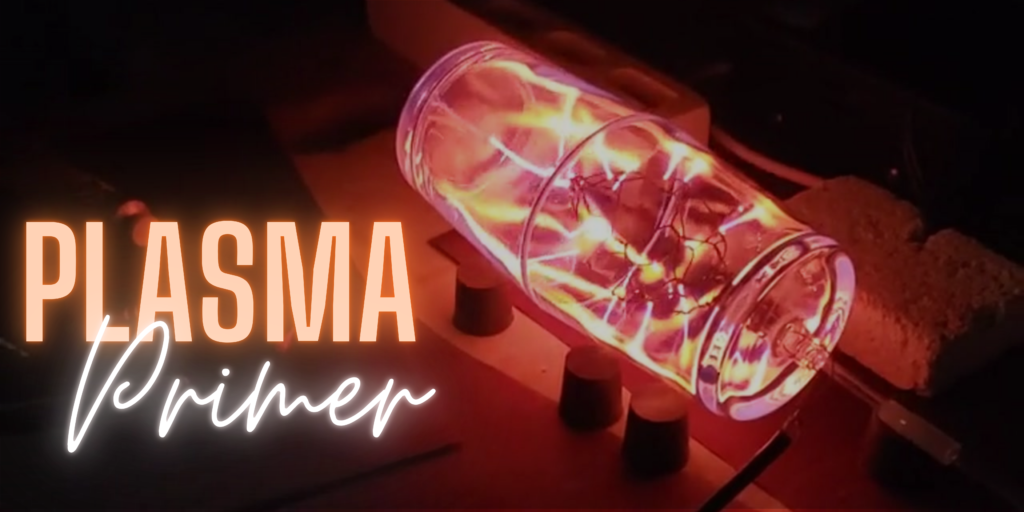Original Resource on www.strattman.comWayne Strattman’s work encompasses over 30 years of innovation in lighted glass plasma technology, as an artist, designer, researcher, teacher, advocate and author.
Since 1983, Wayne Strattman’s Boston-based company Strattman Design has grown to become a global leader in crafting lighted glass plasma displays for science museums, trade shows and industry worldwide. |
Today’s post was brought to you by Wayne Strattman for phosphorus powders! In my most recent collaborative series with Daria Sandburgh called Cumulus Gone Nimbus, one of the consistent struggles with the small vessels is creating colorful effects with gases alone. Other modifiers such as colored glass, well I’m not quite ready to use in flameworking (I tend to waste more than I make), but in observing other artists like Mundy Hepburn and Harriet Schwarzrock, I am curious to explore the use of phosphor powders in clear glass as well as with colored glass, to look deeper into prep and applications.
Thanks to Wayne Strattman, I can share with you several methods of applying phosphors as well as a local distributor through Wayne himself or internationally through Neon Product in the Netherlands.
I hope to follow up on UV lights and some content showing the process for adding these phosphors, pros and cons of applications, cleaning, and others that come to mind.
Thank you for your support,
–Percy Echols II | Taming Lightning
Phosphors were first developed in the 19th century when various natural elements were put in Geissler tubes. After the air was partially evacuated and under the action of a high voltage discharge the elements would glow. The ultraviolet light produced caused the rocks to fluoresce.
When powdered these “rocks” became our first phosphors.
Phosphor technology research progressed through the last century to produce a rainbow of colors.
Phosphors have many technical properties and requirements that fill textbooks but here are some basics for the plasma artist.
- Reflective mode: This means the UV light from the plasma discharge impinges on an internal surface which results in it reflecting a visible light. An example of this is if a sculpture is mounted inside a clear glass envelope containing the plasma. The inner sculpture is coated with phosphor and would reflect colored light. This mode produces the brightest light and brilliant colors. The gas discharge itself will also add its own characteristic body color.
- Transmissive mode: This is what happens in a neon or fluorescent tube. The UV light hits the coating from the backside and transmits visible light which passes through the coating. This method requires careful control of the coating thickness and uniformity or all that will result is a muddy look due to too thick a coating.
Particle size:
- Particle size is important to different phosphor coating techniques.
- Larger particles, for example >5 microns and up, require a binder to bind the particles to the glass. Most coated tubing requires a binder, one that can be cleanly burned off in the presence of air (or at least oxygen) at elevated temperatures. Failure to thoroughly burn this off will lead to reducing the binder to carbon blackening the glass.
- Phosphors milled to <1 micron can be applied with just an alcohol vehicle which will quickly dry leaving a thin coating that readily adheres to the glass.
- The traditional binder for phosphors was nitrocellulose. Currently polyethylene oxide (trade name Polyox)has replaced this.
Applying Phosphors to glass:
Here are 6 common ways to apply phosphors to glass. (note: In all cases the raw phosphors should be finely ground to powder using a mortar and pestle or equivalent. They come already milled to size but may clump together so need to be reduced to powder either when mixing with a liquid vehicle or for dry dust coating.)
- Dipping or suction coating by
dipping the glass or suctioning the phosphor and its liquid vehicle up into a piece and letting it run off uniformly. Small particle phosphors with an alcohol vehicle and larger particle phosphors with a binder both work with this technique. - Brushing, particularly for artwork can give a painterly quality to the coating.Dipping the brush into the vehicle before brushing and applying thin coating adhere better than thicker coatings. Multiple coats are difficult because the base coat tends to be removed when trying to put on additional layers.
- Airbrush sprayed coatings can result in the smoothest, most uniform coatings but strict attendance should be paid for airborne phosphor particles which can be dangerous if inhaled or ingested and so should only be done in a fume hood.Many phosphors can be significantly damaging if inhaled.
- Coating powders with clean sand or glass beads requires a fine powder of phosphor mixed with clean sand or fine glass beads which when shaken or agitated inside the glass piece and then poured out results in a light translucent coating which can tint a plasma discharge.
- “Explosive” coating, despite the name, provides a fairly uniform coating. This method requires dry, finely ground phosphor powder and works best with small, <1 micron particles. The method requires that the tubulation to the plasma piece have a side arm. A small amount of finely powdered phosphor is inserted into the side arm. The plasma piece is evacuated to a reasonable vacuum and the glass tubulation sealed off close to the pump. The contents of the side arm are poured into the tubulation and the tubulation end is cut or broken off. The rapidly inrushing air blows the phosphor throughout the glass piece.
Interesting combinations of phosphor colors can be made with the body colors of the plasma gas itself. For example, a xenon blue plasma combined with a contrasting color like red, green or other color can give a rich multicolored display.
- Pouring liquid phosphor directly into a lamp can give interesting streaks of color. Using heavily thinned phosphors can, by turning and twisting of the glass, direct streams of color to trail throughout the lamp.
*Avoid breathing airborne dust from phosphor powders. Wear a properly rated respirator mask and work in a well ventilated area when mixing/grinding the dry phosphor powders.
*See color chart specifying particle size. Small particle size does not require the use of a binder and will stick by itself using the explosive coating method or can be painted on with alcohol. Larger particle size will require binder to stick. There is no visible difference with such small particle sizes but it makes a difference when choosing a method of application.)
*Isopropyl alcohol can be used as a vehicle to mix with the phosphor powder for painting. It will work best to use 100% Isopropyl alcohol with no water in it.
*Most phosphors appear white until activated under UV light.
*Contact us with any additional questions








